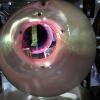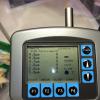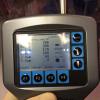Calum, Rich, Matt
HAM4
The soft cover on the South door was not billowing at all. Despite the obviously low purge air and Matt working in HAM4, the initial particle counts were low. Before starting work, I wiped down everything I could reach with a pre-wetted wipe. Calum and I inspected the optic with a green flashlight (not to be confused with the Green Lantern, D1400060). For both faces of SR2, we estimated 25-100 particles per square inch depending on the region. BEFORE applying FC, we found a ~1 inch piece of leftover FC from the alignment layer on the HR side, and what appears to be a long strand of FC on an earthquake stop. There were numerous glove prints and leftover FC on both faces near the barrel. Because the HSTS legs are warped from welding, we had to use 2 washers on a side of the spray cone bracket to keep the cone on its intended track. Not surprisingly, the particle counts spiked while spraying FC. The "CAL Alarm" popped up on the count taken while spraying. I need to look up the settings for the handheld particle counters to check what that means. The FC appeared much thinner and had more bubbles than usual, but there were less cobwebs than we observed on Saturday. We moved on to HAM5 to let the FC dry.
Matt returned later to retract then remove the spray cone. The wipe on the end of the cone stuck against the optic when the cone was retracted. This has never happened before at either site, not even when a cone was left on overnight. I used the same procedure (E1300017) as always. Matt pulled very gently on the wipe, and it separated from the optic. I painted 3 layers of FC around the edges and added a PEEK tab. The painted crust was much darker in color than the sprayed FC.
|
|
Outside chamber (before work) |
Inside chamber (before work) |
3 mins after 1st FC layer |
While spraying 2nd FC layer |
3 mins after 2nd FC layer |
5 min after 2nd FC layer |
3 min after last FC layer |
Outside chamber (before painting) |
Inside chamber (before painting) |
Exiting (Matt) |
|
0.3 um |
10 |
70 |
70 |
918200 |
4330 |
670 |
1380 |
10 |
200 |
850 |
|
0.5 um |
0 |
20 |
20 |
749920 |
3030 |
500 |
1010 |
0 |
40 |
380 |
|
0.7 um |
0 |
20 |
20 |
586250 |
2310 |
340 |
750 |
0 |
30 |
270 |
|
1.0 um |
0 |
10 |
20 |
466730 |
1630 |
270 |
600 |
0 |
20 |
170 |
|
2.0 um |
0 |
10 |
20 |
293620 |
830 |
170 |
340 |
0 |
10 |
70 |
|
5.0 um |
0 |
0 |
0 |
62590 |
60 |
10 |
40 |
0 |
0 |
30 |
|
RH (%) |
35 |
22 |
27 |
30 |
28 |
34 |
27 |
39 |
20 |
31 |
|
Temp (F) |
75 |
75 |
72 |
73 |
73 |
73 |
73 |
75 |
70 |
70 |
HAM5
Like HAM4, there appeared to be very little purge air. Spraying SR2 with FC only a few minutes earlier likely caused the high initial particle count in HAM5. SR3's HR side had 10-30 particles per square inch and a big streak of FC from the alignment layer plus small bits of FC near the barrel. SR3 was sprayed on Saturday. A modified mix with slightly more thinner was used for the 1st layer in an attempt to reduce cobwebbing. It worked, but there was more backsplash (contained by the cone). The standard 1:1 mix ratio of FC and thinner was used for the 2nd and 3rd spray layers.
On Sunday, we removed the cone and painted the crust on SR3. The dried FC spray looked uneven and runny.
|
|
Outside chamber (before work) |
Inside chamber (before work) |
1 min after painting |
Exiting HAM5 (Matt) |
|
0.3 um |
0 |
780 |
320 |
140 |
|
0.5 um |
0 |
390 |
130 |
50 |
|
0.7 um |
0 |
170 |
40 |
30 |
|
1.0 um |
0 |
100 |
30 |
0 |
|
2.0 um |
0 |
60 |
10 |
0 |
|
5.0 um |
0 |
0 |
0 |
0 |
|
RH (%) |
35 |
35 |
33 |
39 |
|
Temp (F) |
74 |
75 |
70 |
71 |
BSC2
The beamsplitter was absolutely filthy, and had over 50-100+ particles per square inch. There were tiny circles all over the HR side that looked like rings left by evaporation. There were noticeably more fibers on the AR side. Both faces had glove prints and lefover FC near the barrel. I didn't get any good pictures unfortunately.
I sprayed both faces on Friday, and painted the crusts on Sunday. Like SR3, the FC on the BS was extremely runny.
|
|
Outside BSC3 (before work) |
Inside BSC3 (before work) |
Inside BSC2 (before work) |
Exiting BSC2 |
|
0.3 um |
70 |
130 |
190 |
360 |
|
0.5 um |
50 |
50 |
120 |
260 |
|
0.7 um |
30 |
30 |
100 |
250 |
|
1.0 um |
20 |
10 |
100 |
230 |
|
2.0 um |
10 |
10 |
70 |
200 |
|
5.0 um |
10 |
0 |
70 |
110 |
|
RH (%) |
36 |
18 |
20 |
20 |
|
Temp (F) |
71 |
71 |
73 |
69 |
I'll add photos soon.




















































